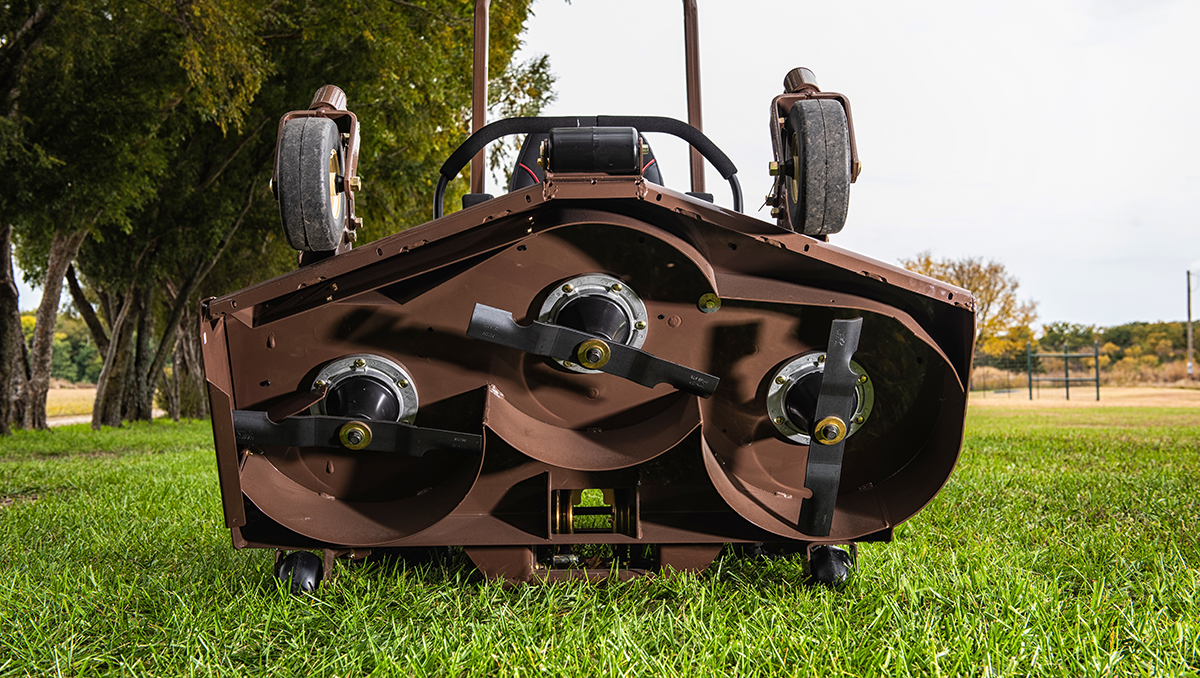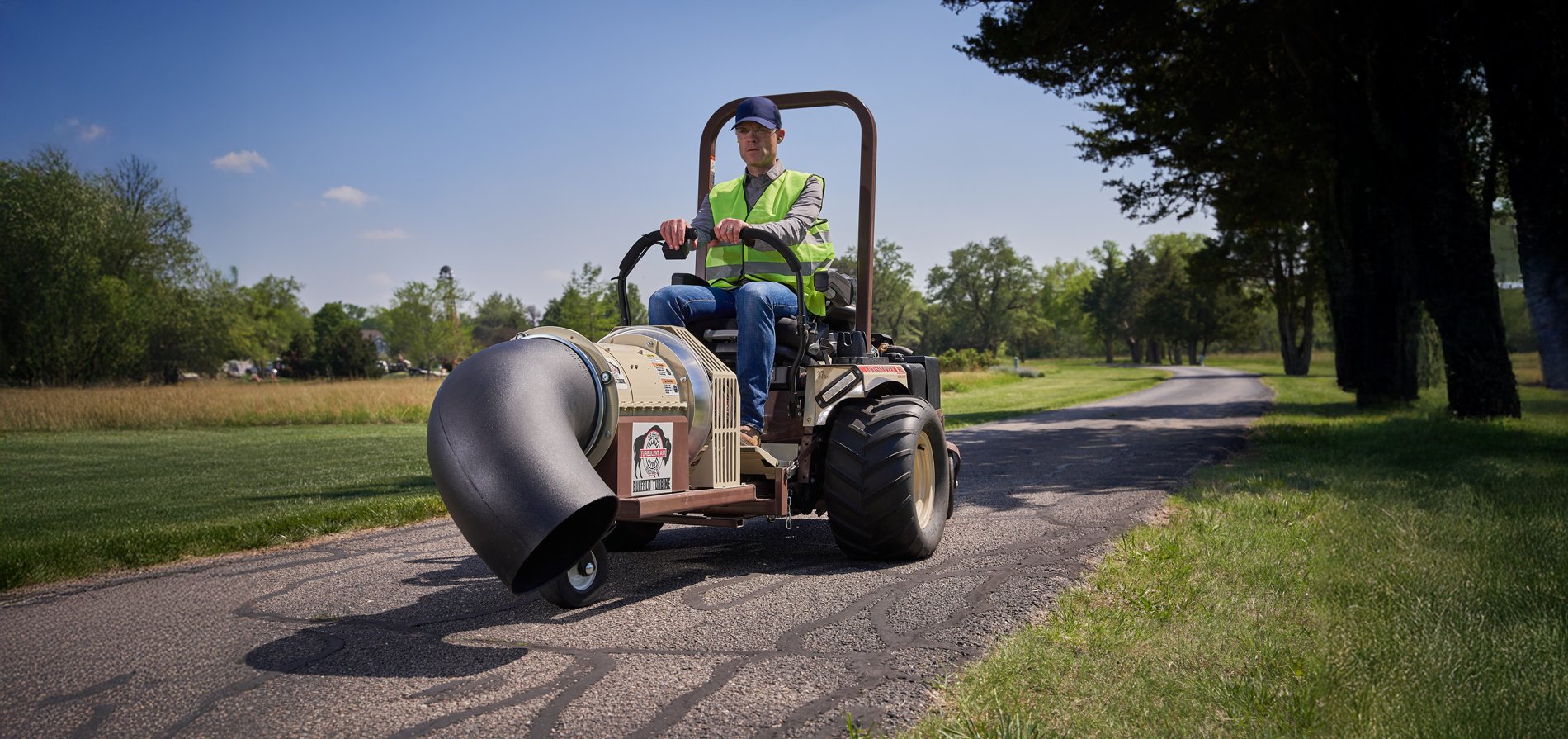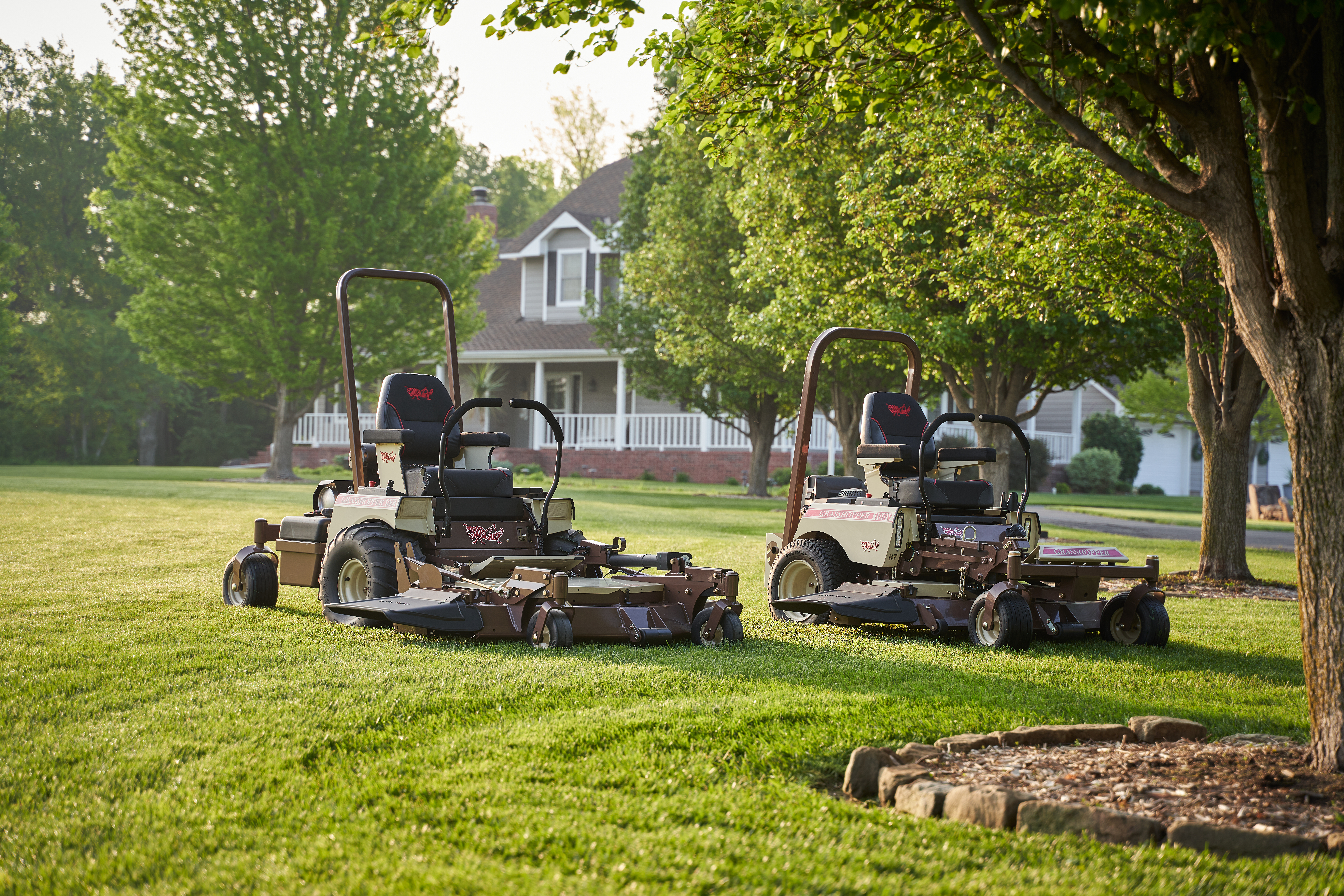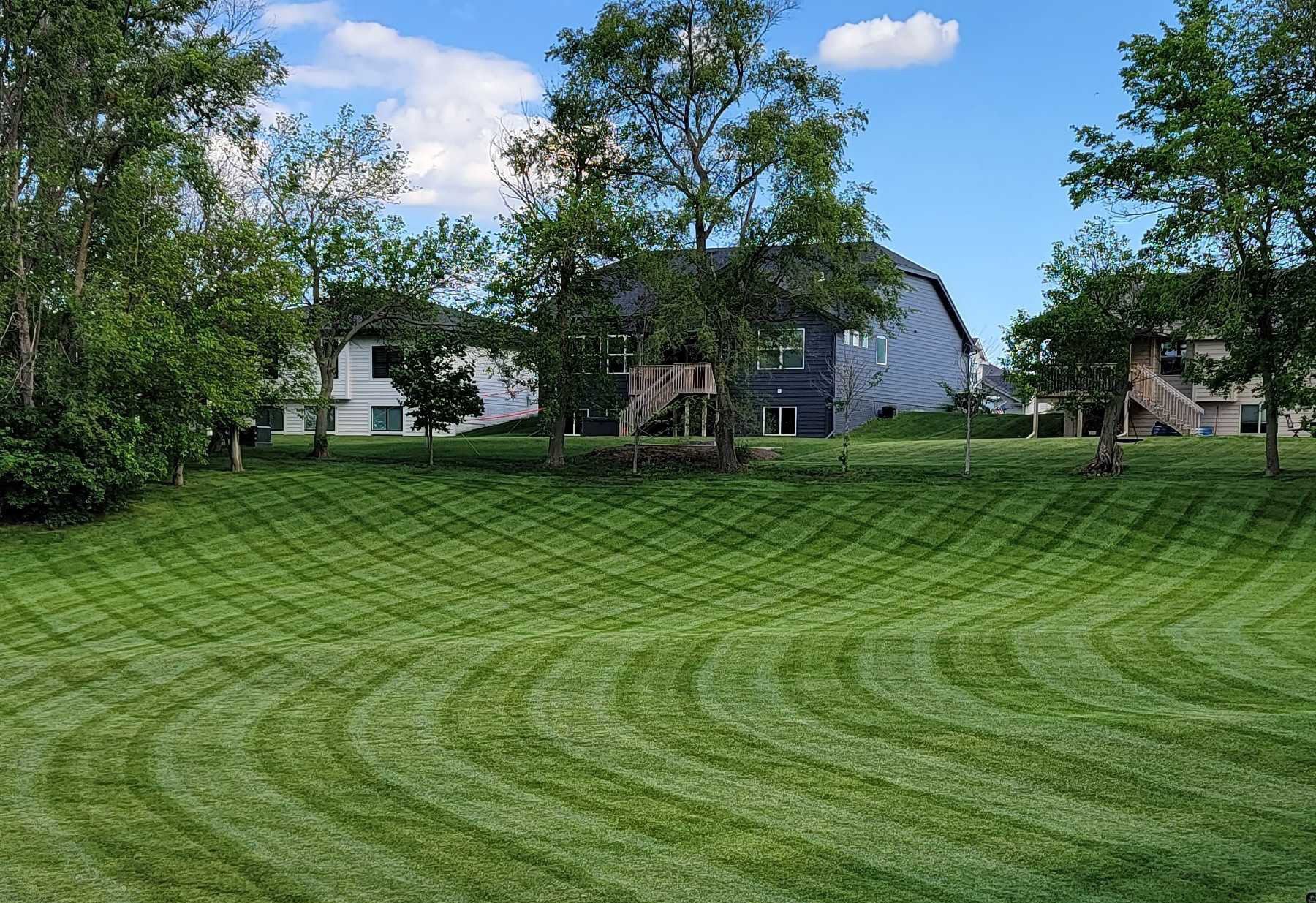Whether we’re talking to customers on the phone, at a trade show, on social media, or at one of our independent sales/service dealerships around the country, there are a handful of questions we’re asked over and over again. We discussed the top five in Part 1. Now here’s a look at five more.
6. Is there really a difference between a front-mount, mid-mount, or stand-on mower?
Absolutely, and each style has its own advantages.
A mid-mount mower’s cutting deck is located directly beneath the operator’s feet, making it a shorter machine that can maneuver in highly confined spaces.
A stand-on mower is an even more compact machine, making it ideal for confined spaces while providing other benefits such as quick entry/exit from the machine, enhanced slope stability, and enhanced visibility because the operator is standing upright. Furthermore, some operators simply find it more comfortable to stand than sit.
Front-mount zero-turn mowers provide a lot of advantages of their own, though, and Grasshopper is one of the few manufacturers that offers them. With the cutting deck in front of the mower, operators have better visibility. A front-mount deck is also able to reach under fences, trees and other obstacles, eliminating some of the string trimming that might be necessary after mowing. The deck is also able to contour to the ground, providing a more consistent cut and smoother ride.
Perhaps the biggest advantage of a Grasshopper FrontMount™ mower is its versatility. The cutting deck can be removed and replaced by a variety of attachments, allowing for more year-round use of a Grasshopper FrontMount mower.
A lot of people recognize that a Grasshopper FrontMount mower is easier to service. An example is Grasshopper's innovative PowerFold® system that allows the deck to easily lift up, making cleaning the deck and servicing blades much easier. During the design process, Grasshopper takes into consideration the accessibility of maintenance for mechanics and homeowners.
The bottom line is that Grasshopper MidMount™, FrontMount and OutStander® Stand-On™ Mowers each have their advantages. It’s important to have a detailed conversation with your Grasshopper dealer to help determine which style will best fit your needs.
7. Why are Grasshopper mowers painted brown and tan, and what’s the story behind the Grasshopper logo?
The original Grasshopper mowers were actually red and white (see photo). Before long, however, the paint scheme evolved to brown and a lighter “lichen green” that was popular in the 1960s. Grasshopper mowers maintained that look for the next 15-plus years before a manufacturing change prompted yet another paint change.
to brown and a lighter “lichen green” that was popular in the 1960s. Grasshopper mowers maintained that look for the next 15-plus years before a manufacturing change prompted yet another paint change.
A powder coat paint line was integrated into the manufacturing process in 1986. The powder coat supplier was unable to provide that “lichen green” Grasshopper had been using. So Grasshopper decided to substitute tan. Now, nearly 40 years later, Grasshopper is still using that same brown/tan color scheme that has become synonymous with the Grasshopper brand.
There’s a functional benefit to the brown/tan color scheme, too. Those colors tend to hold up better over time, whereas vibrant reds, oranges, yellows and greens can often fade after several seasons in the sun. Dust, dirt and other by-products of mowing grass are hidden well on brown/tan. So, while definitely a bit different, brown/tan has proved to be the perfect color combination for a lawnmower–especially for a unique mower like a Grasshopper.
Unlike the paint scheme, the iconic Grasshopper logo hasn’t undergone significant changes over the years. The original logo, created in the mid-1960s, is extremely close to what you see today.
A student studying art and design and known for designing eye-catching posters, was asked if she could create a logo for a new Grasshopper mower being built. She did, using the outline of a “bug” and filling in the letters to spell Grasshopper. Aside from a few subtle changes over the years, it’s the same Grasshopper logo trademarked decades ago and what you see today.
8. Why don’t you offer a striping kit? Does that rubber flap really work?
Specialized striping kits are not necessary to leave pronounced stripes on a freshly cut lawn. The most important factors in striping are grass health, grass height and deck construction. A well-designed deck with enhanced airflow will lift the grass up so it can be cut evenly, while the forward motion of the deck lightly bends the cut grass in the direction the mower is moving.
A heavy-duty rubber flap is standard on most Grasshopper decks, and it does help accentuate the striping effect. But the real purpose of that flap is to prevent an excessive amount of airflow from being lost out the back of the deck. Again, airflow is a very important key to cutting and striping. It’s also important that the deck is pitched properly. Other mower features can also contribute to an impressive striping effect, such as high-lift blades and collection systems that further enhance airflow.
9. Would I be better off buying a mower with a diesel engine?
 Grasshopper was the first mower manufacturer to put a diesel engine on a zero-turn mower in 1983. That said, the benefits of diesel power don’t carry the same value for every single Grasshopper customer.
Grasshopper was the first mower manufacturer to put a diesel engine on a zero-turn mower in 1983. That said, the benefits of diesel power don’t carry the same value for every single Grasshopper customer.
Diesel engines generally last longer, run quieter, provide better torque and burn less fuel. But a diesel-powered mower is also more expensive than a gas-powered counterpart. The customers who tend to get the most value out of a diesel mower are the folks who are tasked with all-day mowing, especially those mowing in rather challenging conditions. For those types of customers, the added durability and power of a diesel engine comes in handy, while the enhanced fuel economy helps save a lot of money over the course of a season.
Even so, if you’re looking for the longest-lasting mower you could ever purchase, and you want to save time and money over the long haul, you can’t go wrong with a Grasshopper diesel mower.
10. Are you in any other countries?
Yes. Grasshopper has built long-standing relationships with valued distributors all over the world, some of which date back to before Grasshopper was even manufacturing mowers. Prior to incorporating The Grasshopper Company in 1969, Moundridge Mfg. was making grain dryers for a global market. Many of the company’s international distributors began selling Grasshopper mowers, too, and continue to sell them to this day. In total, Grasshopper mowers can be found in more than 50 countries.
In fact, Grasshopper was honored to be named 2022 Exporter of the Year by the Export-Import Bank of the United States (EXIM), with nearly one out of every 10 mowers we make destined for the international market.





 to brown and a lighter “lichen green” that was popular in the 1960s. Grasshopper mowers maintained that look for the next 15-plus years before a manufacturing change prompted yet another paint change.
to brown and a lighter “lichen green” that was popular in the 1960s. Grasshopper mowers maintained that look for the next 15-plus years before a manufacturing change prompted yet another paint change.
 Grasshopper was the first mower manufacturer to put a diesel engine on a zero-turn mower in 1983. That said, the benefits of diesel power don’t carry the same value for every single Grasshopper customer.
Grasshopper was the first mower manufacturer to put a diesel engine on a zero-turn mower in 1983. That said, the benefits of diesel power don’t carry the same value for every single Grasshopper customer.